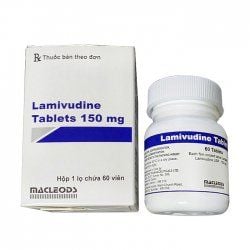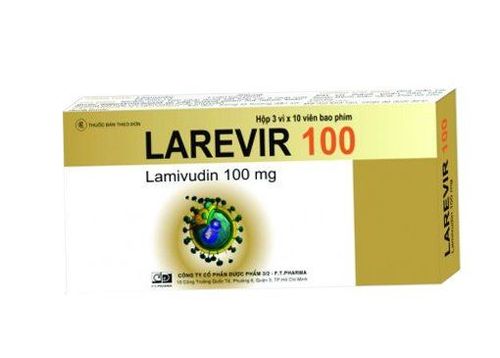This is an automatically translated article.
Lamivase is an antiviral drug with the main ingredient Lamivudine. Drugs with high activity against hepatitis B virus should support effective treatment for a number of related conditions. In addition, Lamivase is also used in combination in the treatment of HIV infection.1. What are the uses of Lamivase?
Lamivase is usually indicated for the treatment of chronic hepatitis B with evidence of hepatitis B virus (HBV) replication with one or more of the following conditions:
Liver enzymes serum ALT 2 times higher than normal often; Compensated or decompensated cirrhosis ; Necrotizing liver disease demonstrated on biopsy; Immunodeficiency; Liver transplant.
2. Instructions on how to take Lamivase
To improve the effectiveness of antiretroviral therapy, the dose of Lamivase must be carefully calculated and prescribed by a qualified doctor. The following Lamivase dosage suggestions are for reference only:2.1. Treatment of HIV infection
For children from 3 months to 12 years old:
Take 4mg Lamivudine/kg, take 1 time every 12 hours. The maximum dose of Lamivudine is 300mg/day. For adolescents from 12 to 16 years old:
People weighing ≥ 50kg: Take 150mg Lamivudine and 300mg Zidovudine, every 12 hours; Persons weighing < 50 kg: There are no adequate data on dosing guidelines. For adults and adolescents ≥ 16 years old:
People weighing ≥ 50kg: Take 150mg Lamivudine and 300mg Zidovudine, every 12 hours; People with weight <50kg: Take 2mg Lamivudine/kg body weight and 4mg Zidovudine/kg body weight, once every 12 hours. For patients with renal impairment: Need to consider dose reduction based on Creatinine clearance (ml/min):
Clearance from 30 - 49 ml/min: Take 150ml x 1 time/day; Clearance from 15 to 29 ml/min: 150mg/day for the first day, 100mg/day for the following days. Drink only 1 time per day; Clearance from 5-14 ml/min: 150mg/day for the first day, 50mg/day for the following days. Drink only 1 time per day; Clearance < 5ml/min: Take 50mg/day on the first day, 25mg on the following days. Drink only once a day.
2.2. Treatment of chronic hepatitis B virus
Adults: Take 100mg x 1 time/day; Children > 2 years old: Take 3mg/kg body weight x 1 time/day. The maximum dose is 100mg/day; Patients with renal impairment need to reduce the dose as directed by the doctor. Other notes:
In case the patient is infected with HIV virus and hepatitis B virus simultaneously, the anti-HIV dose should be used; Lamivudine is not affected by hepatic dysfunction, so no dose adjustment is required in patients with hepatic impairment, unless accompanied by renal impairment; After stopping Lamivase, the patient may develop a relapse of chronic hepatitis B. Therefore, patients should periodically monitor and regularly test liver function for at least 4 months to look for signs of recurrent viral hepatitis; Lamivase does not cure HIV infection, the patient continues to carry HIV disease, including opportunistic infections. Patients need constant monitoring and care.
3. Lamivase side effects
During treatment with Lamivase, users may experience some side effects such as:
Common side effects: Dizziness, headache, insomnia, fatigue, irritability, diarrhea, loss of appetite, increased amylase, paresthesia, myalgia, arthralgia, peripheral neuropathy, nasal symptoms, rash, cough, neutropenia, anemia, increased AST, ALT; Uncommon side effects: Pancreatitis, hyperbilirubinemia, thrombocytopenia. If there are signs, symptoms or laboratory findings that suggest pancreatitis may occur, Lamivase should be discontinued immediately.
4. Notes when taking Lamivase
Lamivase is contraindicated in people who are sensitive to its components (especially Lamivudine).
At the same time, caution should be taken when using Lamivase for the following cases:
For people with impaired renal function, children < 12 years old and adolescents weighing < 50 kg, do not use fixed combination preparations containing Lamivudine. and zidovudine because it is not possible to tailor each drug individually; Pregnant women can take Lamivudine alone, especially when there is a chance of protection from infection to the fetus. But do not use combined oral Lamivudine (including Lamivudine and Zidovudine) for pregnant women; It is not known whether the lamivudine component of Lamivase is absorbed into breast milk and the risk to a nursing infant. However, there is still a high risk of HIV transmission through breast milk. Therefore, HIV-infected mothers should not breastfeed.
5. Lamivase drug interactions
If Lamivase is used at the same time with some drugs / functional foods, there may be an interaction reaction, typically:
Combined with Zidovudine can cause the concentration of this active ingredient to increase significantly in the blood. similar (about 39%); Trimethoprim / Sulfamethoxazole increases the bioavailability of Lamivudine by 44% (44%) and reduces renal clearance by 30%; Although bioavailability was not significantly affected, absorption of Lamivudine was slowed and peak plasma concentrations were 40% lower when the drug was taken on a full stomach compared with the fasted dose.













